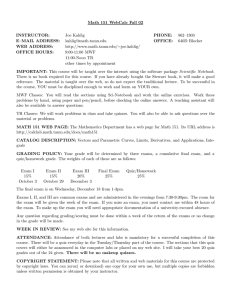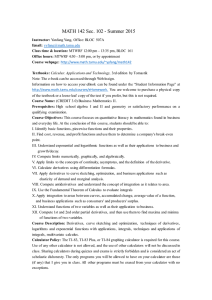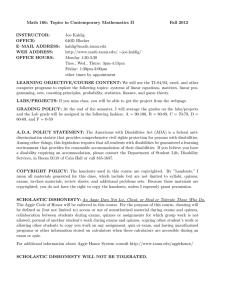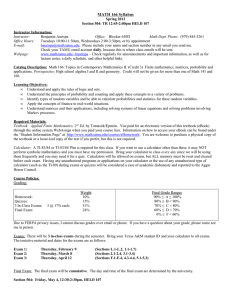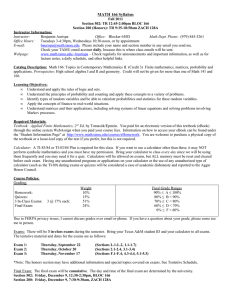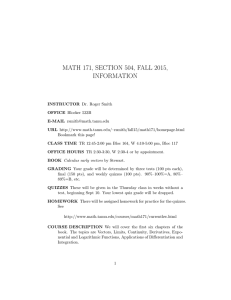Math 142-205 Summer II 2013 Instructor: Ngoc Do Phone: available upon request
advertisement
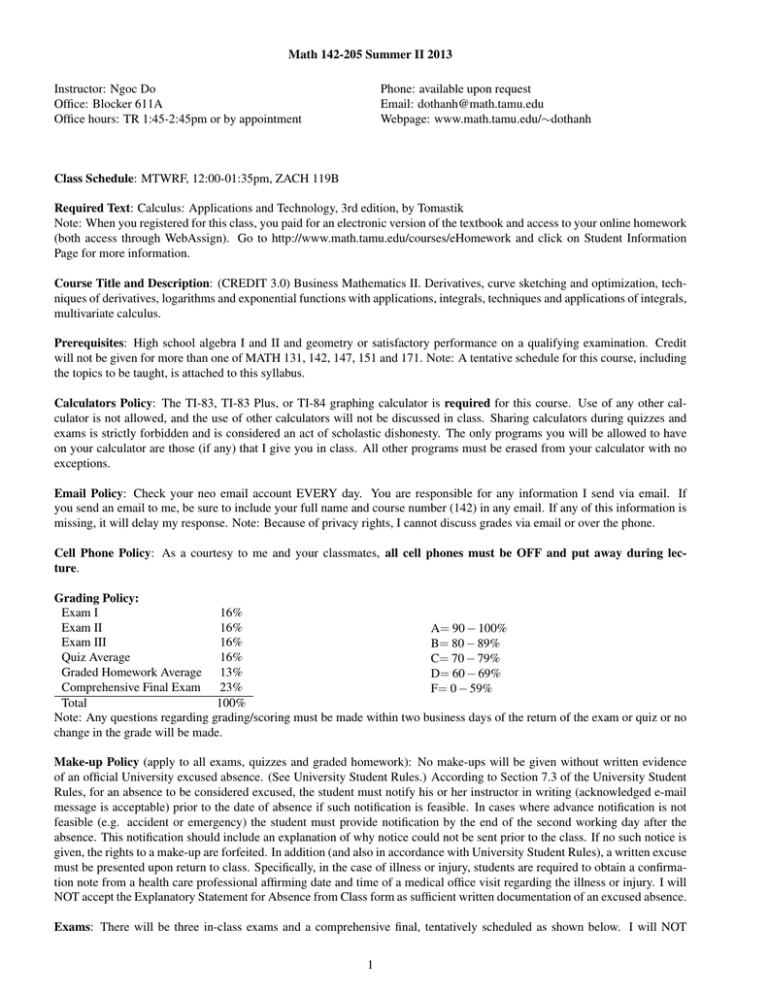
Math 142-205 Summer II 2013 Instructor: Ngoc Do Office: Blocker 611A Office hours: TR 1:45-2:45pm or by appointment Phone: available upon request Email: dothanh@math.tamu.edu Webpage: www.math.tamu.edu/∼dothanh Class Schedule: MTWRF, 12:00-01:35pm, ZACH 119B Required Text: Calculus: Applications and Technology, 3rd edition, by Tomastik Note: When you registered for this class, you paid for an electronic version of the textbook and access to your online homework (both access through WebAssign). Go to http://www.math.tamu.edu/courses/eHomework and click on Student Information Page for more information. Course Title and Description: (CREDIT 3.0) Business Mathematics II. Derivatives, curve sketching and optimization, techniques of derivatives, logarithms and exponential functions with applications, integrals, techniques and applications of integrals, multivariate calculus. Prerequisites: High school algebra I and II and geometry or satisfactory performance on a qualifying examination. Credit will not be given for more than one of MATH 131, 142, 147, 151 and 171. Note: A tentative schedule for this course, including the topics to be taught, is attached to this syllabus. Calculators Policy: The TI-83, TI-83 Plus, or TI-84 graphing calculator is required for this course. Use of any other calculator is not allowed, and the use of other calculators will not be discussed in class. Sharing calculators during quizzes and exams is strictly forbidden and is considered an act of scholastic dishonesty. The only programs you will be allowed to have on your calculator are those (if any) that I give you in class. All other programs must be erased from your calculator with no exceptions. Email Policy: Check your neo email account EVERY day. You are responsible for any information I send via email. If you send an email to me, be sure to include your full name and course number (142) in any email. If any of this information is missing, it will delay my response. Note: Because of privacy rights, I cannot discuss grades via email or over the phone. Cell Phone Policy: As a courtesy to me and your classmates, all cell phones must be OFF and put away during lecture. Grading Policy: Exam I 16% Exam II 16% A= 90 − 100% Exam III 16% B= 80 − 89% Quiz Average 16% C= 70 − 79% Graded Homework Average 13% D= 60 − 69% Comprehensive Final Exam 23% F= 0 − 59% Total 100% Note: Any questions regarding grading/scoring must be made within two business days of the return of the exam or quiz or no change in the grade will be made. Make-up Policy (apply to all exams, quizzes and graded homework): No make-ups will be given without written evidence of an official University excused absence. (See University Student Rules.) According to Section 7.3 of the University Student Rules, for an absence to be considered excused, the student must notify his or her instructor in writing (acknowledged e-mail message is acceptable) prior to the date of absence if such notification is feasible. In cases where advance notification is not feasible (e.g. accident or emergency) the student must provide notification by the end of the second working day after the absence. This notification should include an explanation of why notice could not be sent prior to the class. If no such notice is given, the rights to a make-up are forfeited. In addition (and also in accordance with University Student Rules), a written excuse must be presented upon return to class. Specifically, in the case of illness or injury, students are required to obtain a confirmation note from a health care professional affirming date and time of a medical office visit regarding the illness or injury. I will NOT accept the Explanatory Statement for Absence from Class form as sufficient written documentation of an excused absence. Exams: There will be three in-class exams and a comprehensive final, tentatively scheduled as shown below. I will NOT 1 curve test grades. Tentative Exam Schedule: Exam I: July 18 Exam II: July 30 Exam III: August 8 Final Exam: Tuesday, August 13, 1pm-3pm Quizzes: Announced and unannounced in-class or take-home quizzes will be given throughout the semester during class. Each quiz will be graded on a 10-point scale. One lowest score will be dropped before calculating your combined quiz average. Graded Homework: Graded homework assignments will be completed online using your WebAssign account. Deadlines for online assignments will be clearly stated on the homework website, and I will announce them in class. Additional information regarding online homework: • Go to http://www.math.tamu.edu/courses/eHomework/ to access your online homework (as well as tutorials for how to use WebAssign). • You have a “practice” version and a “homework” version for each assignment. You have 20 attempts for each question in the practice version, and you have 3 attempts for each question in the homework version (you can submit the answer(s) to each question individually). • I will NOT be counting the “practice” versions for a grade. Only the “homework” versions will count for a grade. • After submitting an answer in the practice version, you will see the correct answer. It is very important that you work the practice version at least once so you will see the format you need to use for your answers in WebAssign. • You should use Mozilla Firefox and have the most updated versions of Java and Flash on the computer you are using to alleviate technical problems. • If you ever have technical issues with WebAssign, please fill out the “Student Help Request Form” found at http://www.math.tamu.edu/courses/eHomework/. • I will not give an extension due to technical difficulties, so be sure to start your homework well in advance so that you have time to resolve any technical issues. Grading policy for online homework: Due to the pace of the summer session, your online homework will be graded using a sliding scale (i.e., you do not have to get all of the problems correct to receive a 100%). In WebAssign, when you work a problem correctly, you will see that you have earned one point (partial points are possible for questions with multiple parts). Since each homework has a different number of problems and we are using a sliding scale, each homework will be worth a total of 10 points (regardless of the number of questions in the assignment). The following categories are based on the number of questions in each homework. In each category, the number of WebAssign points necessary to receive the corresponding homework points is shown. Remember, for each homework, you can receive up to 10 homework points (this would mean getting a 100%). You will need to keep up with your homework grade for each assignment since W.A. will only show the number of problems correct. Homework has 16 or more questions: W.A. Points 0 more than 0 but less than 2 2 or more but less than 4 4 or more but less than 6 6 or more but less than 8 8 or more 2 H.W. Points 0 2 4 6 8 10 Homework has 10 to 15 questions (inclusive): W.A. Points 0 more than 0 but less than 2 2 or more but less than 4 4 or more but less than 6 6 or more H.W. Points 0 2 5 8 10 Homework has 4 to 9 questions (inclusive): W.A. Points 0 more than 0 but less than 1 1 or more but less than 2 2 or more but less than 3 3 or more H.W. Points 0 3 5 8 10 Example: The homework for section 1.5 contains 16 questions. After 3 attempts, W.A. shows you have earned 6.5 points (6.5 problems correct). Then, your homework grade is 8/10 (or 80%). Example: The homework for section 5.6 contains 10 questions. After 3 attempts, W.A. shows you have earned 2 points (2 problems correct). Then, your homework grade is 5/10 (or 50%). Example: The homework for section 6.4 contains 5 questions. After 3 attempts, W.A. shows you have earned 0.5 points (1/2 of a problem correct). Then, your homework grade is 3/10 (or 30%). Suggested Homework: A list of suggested homework problems from your textbook can be found on my web page. These problems will not be collected for a grade, but completing them is essential to doing well in the course. Attendance: I STRONGLY suggest that you make every attempt to not miss a single day of lecture. Falling behind in this course can be very detrimental to your grade. Scholastic Dishonesty: You are encouraged to work together on the suggested homework problems, but do not copy another students work. Copying work done by others, either in class or out of class, is an act of scholastic dishonesty and will be prosecuted to the full extent allowed by University policy. Storing formulas or unauthorized programs in your calculator is also an act of scholastic dishonesty and will not be tolerated. Using or having an unapproved program or any formulas stored in your calculator during an exam will result in a zero on the exam. Always abide by the Aggie Code of Honor: An Aggie does not lie, cheat, or steal or tolerate those who do. Please refer to Honor Council Rules and Procedures at http://www.tamu.edu/aggiehonor for more information on academic integrity and scholastic dishonesty. Extra Help: Please feel free to ask questions in class. If you need more help, come by my office during office hours or make an appointment to see me. The Math Department also offers help sessions. Help sessions will begin the second week of classes and have drop-in hours where you can get help with your homework or other problems. Also, the link to the problems and solutions for the Spring 2013 Math 142 Week in Review is posted on our course web page. You should work as many problems as you can so that you will be prepared for quizzes and exams. ADA Policy Statement: The Americans with Disabilities Act (ADA) is a federal anti-discrimination statute that provides comprehensive civil rights protection for persons with disabilities. Among other things, this legislation requires that all students with disabilities be guaranteed a learning environment that provides for reasonable accommodation of their disabilities. If you believe you have a disability requiring an accommodation, please contact the Department of Student Life, Services for Students with Disabilities, in Room B118 of the Cain Hall or call 845-1637. Copyright Policy: All printed materials including (but not limited to) handouts, quizzes, exams, and information found on the web are protected by copyright laws. One xerox copy (or download from the web) is allowed for personal use. Multiple copies or the sale of any of these materials is strictly prohibited and will be prosecuted to the full extent of the law. 3 Learning Objectives: • Identify basic functions and their properties. • Construct, graph, and evaluate piece-wise defined functions. • Find cost, revenue, and profit functions and use them to determine a company’s break-even point. • Understand exponential and logarithmic functions as well as their applications to business and growth and decay. • Compute limits numerically, graphically, and algebraically, and apply them to the concepts of continuity and asymptotes. • Understand the limit definition of the derivative and calculate derivatives of various functions using the limit definition and differentiation formulas. • Apply knowledge of derivatives to business applications such as elasticity of demand and marginal analysis. • Algebraically determine where a function is increasing/decreasing, has relative extrema, is concave upward/downward, and has inflection points by interpreting its first and second derivatives. • Sketch the graph of a function given information about its first and second derivatives as well as other pertinent information (domain, asymptotes, and intercepts). • Find the relative/absolute extrema of functions including optimization applications. • Compute antiderivatives and understand the concept of integration as it relates to area. • Use the Fundamental Theorem of Calculus to evaluate integrals, including the method of substitution. • Apply integration as it relates to area between curves, accumulated change, the average value of a function, and further applications to business such as consumers’ and producers’ surplus. • Understand functions of two variables as well as their application to business. • Compute 1st and 2nd order partial derivatives, and then use them to find maxima and minima of functions of two variables. Tentative weekly schedule: (Any changes will be reflected on the calendar on our course web page.) Week # 1 Lecture Material (Sections) A.8, 1.0, 1.1 topics, 1.2 topics, 1.3 1 1.5, 3.1, 3.2 2 2 3.3, Review Exam 1, 4.1, 4.2 2 4.3, 4.4, 4.5 3 5.1, 5.2, 5.3 3 3 4 5.4, 5.5 5.6, Review Exam 2, 6.1, 6.2 4 6.3, 6.4, 6.5 4 5 6.6, 6.7 topic 8.1, 8.2, Review 5 6 Exam 3, 8.3, Review FINAL EXAM Description Basic Functions and Shifts, Complete Graphs, Overview of Increasing/Decreasing, Concavity, and Continuity, Piecewise-Defined Functions, Break-Even Analysis and Market Equilibrium, Exponential Functions Logarithmic Functions, Limits and Continuity, Rates of Change The Derivative, Review Exam 1 Exam 1 covering A.8, 1.0, 1.1 topics, 1.2 topics, 1.3, 1.5, and 3.1-3.3 Simple Derivative Rules and Marginal Analysis, Product and Quotient Rules Chain Rule, Derivatives of Exponential and Logarithmic Functions, Elasticity of Demand Analyzing Graphs with the First Deriative, Analyzing Graphs with the Second Derivative, Limits at Infinity Curve Sketching Techniques, Absolute Extrema Optimization, Review Exam 2 Exam 2 covering 4.1-4.5 and 5.1-5.6 Antiderivatives, Substitution Riemann Sums and Estimating Distance, The Definite Integral, Fundamental Theorem of Calculus and Average Value of a Function Area Between Curves, Producers’ and Consumers’ Surplus Functions of Several Variables, Partial Derivatives, Review Exam 3 Exam 3 covering 6.1-6.6, 6.7 topic, and 8.1-8.2, Extrema Review for Final Exam Comprehensive Final Exam covering all previous sections as well as 8.3 4
